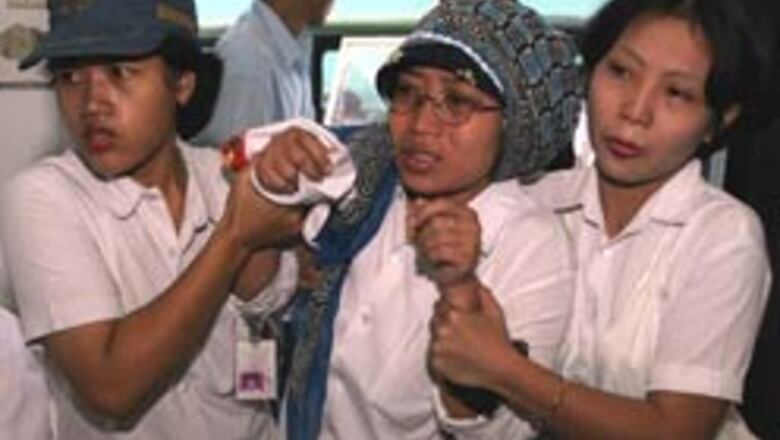
views
Bantul (Indonesia): Exhausted and grieving survivors dug through their crumpled homes on Sunday searching for clothes, food and valuables after a powerful earthquake hit central Indonesia, killing more than 4,300 people.
The magnitude-6.3 quake struck early on Saturday and injured thousands more in the heart of densely populated Java Island, in the country's worst disaster since the 2004 tsunami.
It also triggered fears that a nearby rumbling volcano would erupt and caused serious damage to the world-famous 9th century Prambanan temple.
The disaster zone stretched across hundreds of square kilometers (square miles) of mostly farming communities in Yogyakarta province. The worst devastation was in the town of Bantul, which accounted for three-quarters of the deaths. Eighty percent of the homes were flattened.
''I have to start my life from zero again,'' said Poniran, whose 5-year-old daughter Ellie was killed in the quake.
Poniran dug up his still-breathing daughter from the rubble of her bedroom, but she died in a hospital awaiting treatment along with hundreds of others.
''Her last words were 'Daddy, Daddy,''' he said.
At least 4,332 people were killed in the quake, according to command post officials from the affected areas and local government official Idham Samawi.
The social ministry said around 4,600 died, but numbers in one of the hardest hit districts were disputed.
Another 200,000 people were left homeless, according to the International Federation of Red Cross and Red Crescent.
Tens of thousands spent the night Saturday sleeping in any open space available - on streets, in cassava fields, even on the narrow paths between rice fields. Power and telephone service was out across much of the region, adding to the terror of some 450 aftershocks, the strongest measuring 5.2.
Survivors searched the ruins of their homes on Sunday for anything still usable and complained that they hadn't received any aid.
''We're short of everything - clothes, food, water, all are gone. We are poor people, but our lives still matter,'' said Budi Wiyana, 63, whose house was destroyed.
Doctors struggled to care for the injured, hundreds of whom were lying on plastic sheets, straw mats and even newspapers outside overcrowded hospitals, some hooked to intravenous drips dangling from trees.
Bloodstains littered the floor at Yogyakarta's Dr. Sardjito Hospital, along with piles of soiled bandages and used medical supplies.
Relatives fanned victims in the heat in temporary shelters set up in the parking lot and corridors.
PAGE_BREAK
''We have too many patients and they're still arriving,'' said Aru, a doctor, adding that the hospital had received more than 2,000 patients.
Though some corpses were pulled from the rubble early Sunday, residents in villages visited by reporters said there were few people or bodies trapped beneath collapsed houses, mostly simple brick and wood structures.
But in Peni, a small village on Bantul's southern outskirts, 20 residents were not ready to give up. They found the bodies of a woman and her three children Saturday, and were still trying to find the family's father, Purwoko.
Most of the dead were buried in village graveyards within hours of the disaster, in line with Islamic tradition.
In Peni, villagers set up simple clinics to treat injuries, but were hampered by shortages of medicine and equipment. A group of women cooked catfish caught in a nearby pond for dozens of people huddled under a large tent.
The quake was the latest in a series of disasters to hit Indonesia - including the 2004 tsunami that killed 131,000 people in Aceh province, terrorist attacks, a widening bird flu outbreak and the threat of eruption from nearby Mount Merapi.
The quake's epicenter was 80 kilometers (50 miles) south of Merapi, and activity increased soon after the temblor. A large burst spewed hot clouds and sent debris cascading some 3.5 kilometers (two miles) down its western flank. No one was injured because nearby residents had already been evacuated.
Bambang Dwiyanto of the Energy and Mineral Ministry could not say whether the quake caused the volcanic activity but warned that it could trigger a larger eruption.
International agencies and other nations pledged millions of dollars of aid.
Officials said the famed 7th century Borobudur Buddhist temple, one of Indonesia's most popular tourist attractions, was not affected by the quake.
But Prambanan, a spectacular Hindu temple to the southeast, suffered serious damage, with hundreds of stone carvings and blocks scattered around the ancient site.
It will be closed to the public until archeologists are able to determine whether the foundation was damaged, said Agus Waluyo, head of the Yogyakarta Archaeological Conservation Agency.
Close to 1 million tourists visit the Borobudur and Prambanan temples every year.




















Comments
0 comment